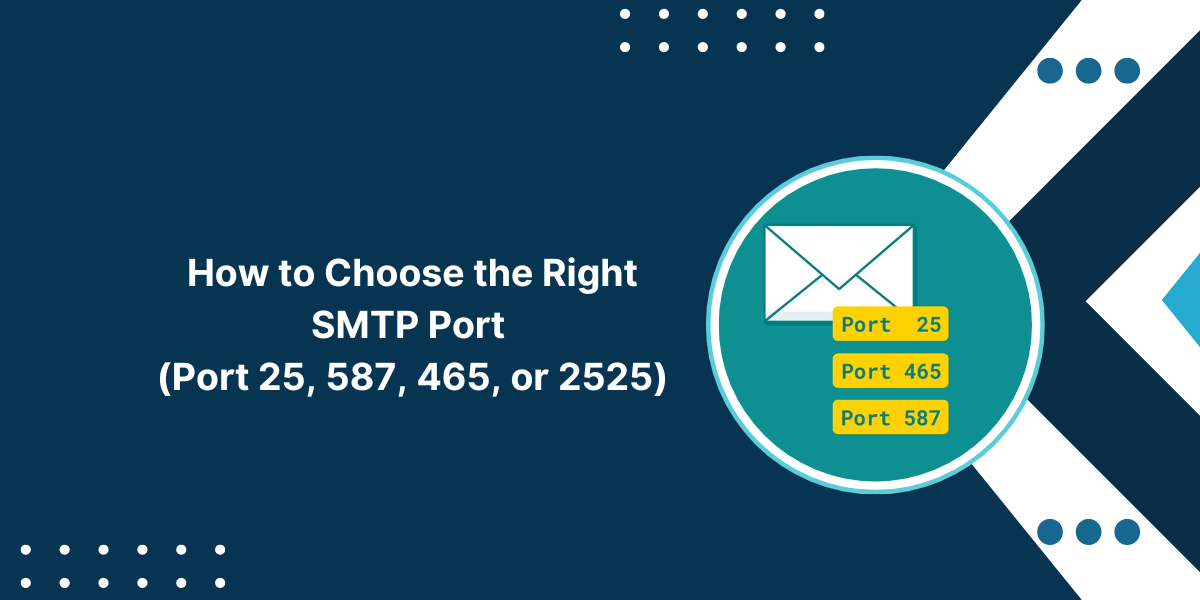Understanding Ports 25, 587, 465, or 2525
Sending email via SMTP (Simple Mail Transfer Protocol) requires connecting to a server on a specific port. While the default SMTP port is 25, many providers now use alternative ports like 587 and 465 for increased security and reliability. Choosing the right SMTP port is important to ensure your outgoing email gets delivered smoothly and securely.
In this guide, we will compare the most commonly used SMTP ports—25, 587, 465, and 2525—and discuss their key differences, advantages, and disadvantages. We’ll also cover how to check which ports your email provider supports and tips for troubleshooting connection issues related to blocked or incorrect ports.
Understanding SMTP ports will help you configure your email client or application to use the optimal port for stable and secure mail delivery.
Key Takeaways
- SMTP ports 25, 587, 465, and 2525 are commonly used for sending outgoing emails. Port 25 is the default SMTP port and is often blocked by ISPs.
- Port 587 is recommended for most users, as it supports TLS encryption. Port 465 uses legacy SSL encryption.
- Port 2525 is an alternative SMTP submission port supported by some email providers like Outlook and Hotmail.
- Check your email provider’s documentation to see which ports they recommend using. Most support 587 and 465.
- Using the correct SMTP port ensures your email is delivered reliably and securely. If you have issues, test different ports.
- When choosing an SMTP port, encryption like TLS or SSL should be enabled for security. Avoid plain text connections.
- Firewalls, ISPs, and email providers may block certain ports, so be prepared to try different ones if needed.
- SMTP connection errors often indicate a blocked port. To troubleshoot, try alternate ports or contact your ISP/email provider.
Overview of Common SMTP Ports
Port 25
Port 25 is the standard SMTP port assigned by the Internet Assigned Numbers Authority (IANA). For many years, SMTP servers listened on port 25 to receive outgoing mail from email clients and other mail transfer agents (MTAs).
However, due to abuse by spammers, many major ISPs started blocking outbound connections to port 25. As a result, this port is no longer recommended for general SMTP usage in most cases.
Port 587
Port 587 is the default SMTP submission port. It supports Transport Layer Security (TLS) encryption, which allows secure transfer of emails. Most modern email providers recommend using port 587 over port 25.
The main benefits of 587 are:
- Supports TLS encryption for secure connections
- Typically not blocked by ISPs like port 25
- Easy to enable TLS support in email client settings
Port 587 has become the standard for secure SMTP email submission for both residential and business use.
Port 465
Port 465 is used for SMTP connections over SSL (Secure Sockets Layer). SSL provides legacy encryption and is supported by most email services for compatibility reasons.
Some key points about port 465:
- Uses legacy SSL encryption protocol
- Supported by all major email providers
- Less likely to be blocked than Port 25
- SSL usually needs manual configuration in email clients
While port 465 is reliable, port 587 is generally preferred because TLS is more modern and automatically supported by most email clients.
Port 2525
Port 2525 is an alternate SMTP submission port used by some providers, such as Outlook.com and Hotmail. It functions similarly to port 587 but is less commonly used.
The main differences with port 2525 are:
- Primarily supported by Microsoft email services
- Limited adoption beyond Outlook.com/Hotmail
- Provides no encryption by default – needs TLS enabled
Unless you specifically use a Microsoft-based email provider, port 2525 does not offer advantages over the more ubiquitous 587 or 465 ports.
How to Choose the Right SMTP Port
So, which SMTP port should you use? Here are some guidelines:
- Check your email provider’s docs: Most providers clearly specify which SMTP ports work or are recommended. This should be your first step.
- Try port 587 first: For general SMTP submission, port 587 is the modern standard and works with all popular email services when TLS encryption is enabled. This is the best port to try first.
- Use port 25 for mail servers: If you are running your own mail server, port 25 is appropriate. However, make sure to implement strong security, such as TLS and authentication.
- Use port 465 if 587 is blocked: In some cases, port 587 may be blocked by your ISP or firewall. Port 465 is a reliable fallback with SSL encryption.
- Enable TLS encryption: Regardless of port, make sure to enable TLS or SSL for secure connections. Never send emails in plain text.
- Test different ports: If you are having connection issues, systematically try ports 25, 587, 465, and 2525 to identify any blocked ports.
Checking Your Email Provider’s Recommended Ports
Rather than guessing which SMTP port to use, the easiest approach is to check your email provider’s help docs or support articles. Most providers give clear guidance on which ports work best for their SMTP servers.
For example:
- Gmail: Uses port 587 with TLS required. Ports 25, 465, and 2525 are blocked.
- Outlook/Hotmail: Recommends port 587 but also supports 25 and 2525. TLS should be enabled.
- Yahoo Mail: Port 587 is recommended with TLS encryption. Port 25 is no longer supported.
- Fastmail: Supports ports 25, 587, and 465. Recommends 587 with TLS.
- Zoho Mail: Allows ports 587 and 465. 587 is preferred with TLS enabled.
The best practice is to search “[provider name] SMTP ports” and check the latest recommendations directly from the source. This eliminates guesswork when choosing the right port.
Troubleshooting SMTP Port Issues
If you are unable to send email, the problem often boils down to incorrect or blocked SMTP ports:
- Connection timed out. Your ISP or firewall is blocking the SMTP port. Try an alternate port, like 587 or 465.
- Connection refused: The server is not listening on that port. Double-check which ports your email provider supports.
- SMTP authentication failure: Some ISPs block authenticated SMTP access on certain ports. Use your provider’s recommended submission port.
- TLS/SSL issues: Make sure encryption is enabled in your email client and permitted by the server. Port 587 needs TLS, and 465 needs SSL.
- Unencrypted connection: Do not allow your emails to be sent in plain text. Always use TLS on port 587 at a minimum.
Carefully reading the error messages and checking the SMTP logs will help determine any issues with blocked or incorrect ports. Enabling email client debugging provides more detailed technical output for troubleshooting.
If problems persist after trying all the common SMTP ports, contact your email provider or ISP support for assistance. They can look for restrictions imposed, such as port blocking or throttling.
Best Practices When Using SMTP Ports
Here are some best practices to keep in mind when using SMTP ports for sending email:
- Use encryption: Enable TLS on port 587 or SSL on port 465 for secure connections. Never send mail in plain text.
- Check for recommended ports: Your email provider will specify which SMTP ports work best for their service. Follow their guidance.
- Try different ports: If your preferred port is blocked or having issues, systematically try ports 25, 587, 465, and 2525 to identify a working port.
- Avoid port 25 if possible: Port 25 is increasingly being blocked. Use submission ports like 587 whenever possible for greater reliability.
- Watch for throttling: If you are sending high volumes, your ISP may throttle certain ports. Rotate among multiple ports to maintain performance.
- Check server documentation. If you are running your own mail server, verify which SMTP ports are exposed to external connections based on your firewall rules.
- Test configurations: Always test that your chosen SMTP port works correctly by sending emails before rolling out application updates, migrating email clients, or making other changes.
Final Thoughts
Choosing the right SMTP port is crucial for reliable and secure email delivery. Standard port 25 is increasingly blocked, so submission ports like 587 and 465 are recommended for most users. Port 587 supports easy TLS encryption, while 465 uses legacy SSL. Check your email provider’s documentation to see which SMTP ports they allow and suggest using. Enabling encryption is mandatory regardless of the port for protecting your emails.
If you experience issues like timeouts or connection failures, methodically try ports 25, 587, 465, and 2525 to identify any blocked ports. SMTP connection errors frequently indicate port blocking or incorrect configurations. Always test your selected port by sending emails after making changes or signing up with a new provider. Following best practices for using SMTP ports will prevent delivery issues and ensure your important messages reach their recipients without problems. With the right troubleshooting steps and proper port selection, you can overcome most SMTP port challenges.
FAQs about SMTP Ports
Why are most ISPs blocking port 25?
ISPs often block port 25 to limit spam and malicious traffic. Port 25 does not support TLS encryption. Using more secure alternatives like port 587 helps ISPs reduce threats on their networks.
Is port 587 or 465 better?
Port 587 is recommended for most users as it is standards-based, widely supported, and enables easy TLS encryption. However, some email providers may prefer port 465 with legacy SSL, so always check their documentation.
What happens if I use the wrong SMTP port?
If you use an incorrect SMTP port, you will get connection errors when trying to send emails. Common issues include timeout errors, TLS negotiation failures, or the server actively refusing connections.
Is Port 80 and Port 443 Different from SMTP Port?
Yes, ports 80 and 443 are different from SMTP ports.
How can I tell if my SMTP port is being throttled?
Signs of port throttling include:
- Intermittent connection errors.
- Very slow email sending.
- Limits on the number of messages per minute you can send.
Rotate among different SMTP ports and monitor performance. Contact your ISP if throttling is suspected.
Can I use multiple SMTP ports?
Yes, you can configure your email client or application to try multiple SMTP ports if the first one fails. This provides redundancy in case certain ports are temporarily blocked or blacklisted.
How do I check which SMTP ports my email provider allows?
The easiest way is to search for their help documentation or knowledge base articles on “SMTP ports.” Most providers give clear guidance on recommended vs supported ports. You can also try contacting their technical support.
I keep getting “Connection timed out” errors: what should I try?
This usually indicates that your outbound SMTP port is being blocked by your ISP or firewall. Try alternate submission ports like 587 or 465, enable TLS encryption, or contact your ISP/network admin to allow the SMTP port.
Should I use port 2525 instead of 587?
Port 2525 is only used by a small number of email providers. For most users, port 587 is recommended over 2525 due to wider compatibility and support for TLS encryption. Only use port 2525 if specifically instructed by your email provider’s documentation.
Is port 25 still usable if my ISP does not block it?
While port 25 may work in some networks, it is considered outdated and insecure for general use as it does not support TLS. Port 587 should be used instead for modern encryption and reliability. Only use port 25 for legacy mail server environments.

Priya Mervana
 Verified Web Security Experts
Verified Web Security Experts
Priya Mervana is working at SSLInsights.com as a web security expert with over 10 years of experience writing about encryption, SSL certificates, and online privacy. She aims to make complex security topics easily understandable for everyday internet users.



